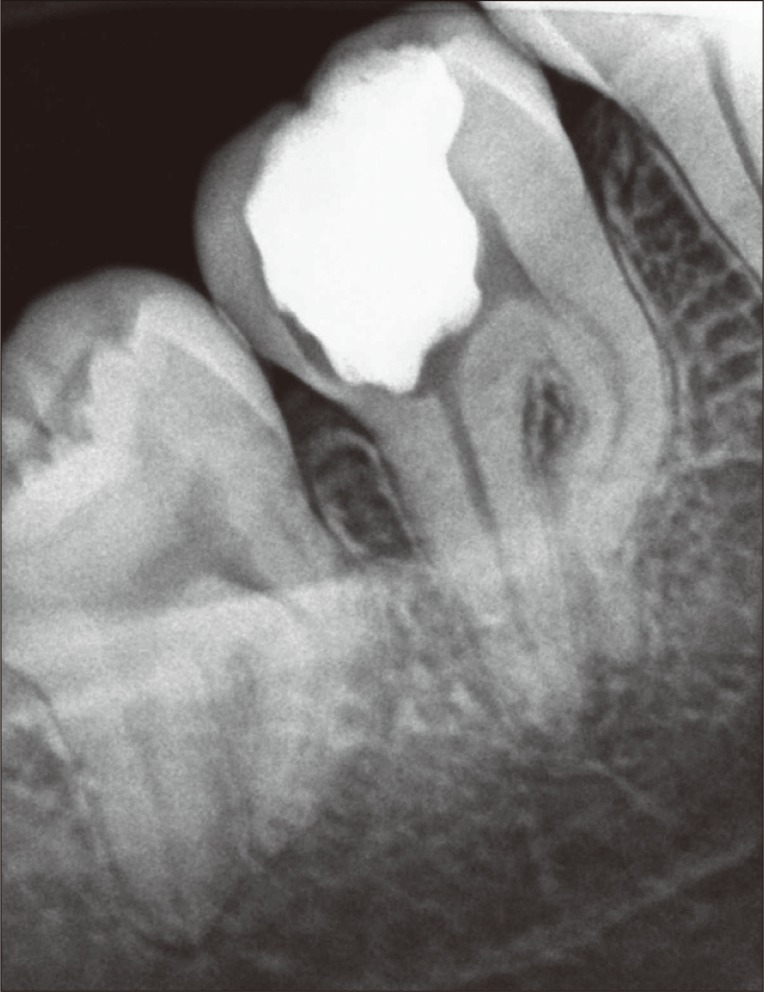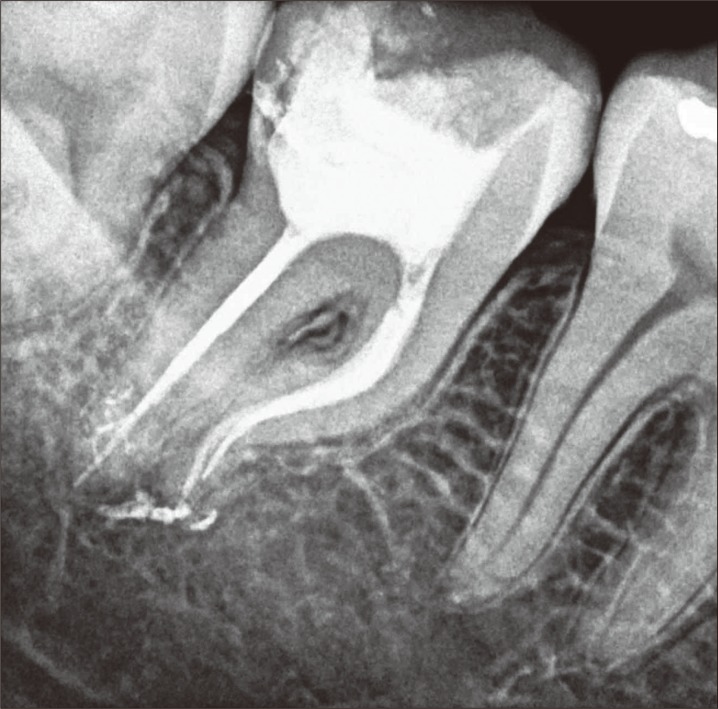Restor Dent Endod.
2013 Aug;38(3):167-171.
Endodontic treatment of mandibular molar with root dilaceration using Reciproc single-file system
- Affiliations
-
- 1Department of Endodontics, Federal University of Amazonas School of Dentistry, Manaus, AM, Brazil.
- 2Department of Endodontics, State University of Amazonas School of Dentistry, Manaus, AM, Brazil.
- 3Department of Dental Materials and Prosthodontics, University of Sao Paulo Ribeirao Preto School of Dentistry, Ribeirao Preto, SP, Brazil. drlucas.garcia@gmail.com
Abstract
- Biomechanical preparation of root canals with accentuated curvature is challenging. New rotatory systems, such as Reciproc, require a shorter period of time to prepare curved canals, and became a viable alternative for endodontic treatment of teeth with root dilaceration. Thus, this study aimed to report a clinical case of endodontic therapy of root with accentuated dilaceration using Reciproc single-file system. Mandibular right second molar was diagnosed as asymptomatic irreversible pulpitis. Pulp chamber access was performed, and glide path was created with #10 K-file (Dentsply Maillefer) and PathFile #13, #16 and #19 (Dentsply Maillefer) up to the temporary working length. The working length measured corresponded to 20 mm in the mesio-buccal and mesio-lingual canals, and 22 mm in the distal canal. The R25 file (VDW GmbH) was used in all the canals for instrumentation and final preparation, followed by filling with Reciproc gutta-percha cones (VDW GmbH) and AH Plus sealer (Dentsply Maillefer), using thermal compaction technique. The case has been receiving follow-up for 6 mon and no painful symptomatology or periapical lesions have been found. Despite the difficulties, the treatment could be performed in a shorter period of time than the conventional methods.
Keyword
MeSH Terms
Figure
Reference
-
1. Prichard J. Rotation or reciprocation: a contemporary look at NiTi instruments? Br Dent J. 2012; 212:345–346. PMID: 22498554.
Article2. Elayouti A, Chu AL, Kimionis I, Klein C, Weiger R, Löst C. Efficacy of rotary instruments with greater taper in preparing oval root canals. Int Endod J. 2008; 41:1088–1092. PMID: 19133098.
Article3. Marchesan MA, Arruda MP, Silva-Sousa YT, Saquy PC, Pecora JD, Sousa-Neto MD. Morphometrical analysis of cleaning capacity using nickel-titanium rotary instrumentation associated with irrigating solutions in mesiodistal flattened root canals. J Appl Oral Sci. 2003; 11:55–59. PMID: 21409340.
Article4. Yared G. Canal preparation using only one Ni-Ti rotary instrument: preliminary observations. Int Endod J. 2008; 41:339–344. PMID: 18081803.
Article5. Hülsmann M, Peters OA, Dummer PMH. Mechanical preparation of root canals: shaping goals, techniques and means. Endod Topics. 2005; 10:30–76.6. Alapati SB, Brantley WA, Iijma M, Clark WA, Kovarik L, Buie C, Liu J, Ben Johnson W. Metallurgical characterization of a new nickel-titanium wire for rotary endodontic instruments. J Endod. 2009; 35:1589–1593. PMID: 19840654.
Article7. Gutmann JL, Gao Y. Alteration in the inherent metallic and surface properties of nickel-titanium root canal instruments to enhance performance, durability and safety: a focussed review. Int Endod J. 2012; 45:113–128. PMID: 21902705.8. Kim HC, Kwak SW, Cheung GS, Ko DH, Chung SM, Lee W. Cyclic fatigue and torsional resistance of two new nickel-titanium instruments used in reciprocation motion: Reciproc versus WaveOne. J Endod. 2012; 38:541–544. PMID: 22414846.
Article9. Gavini G, Caldeira CL, Akisue E, Candeiro GT, Kawakami DA. Resistance to flexural fatigue of Reciproc R25 files under continuous rotation and reciprocating movement. J Endod. 2012; 38:684–687. PMID: 22515903.
Article10. Bürklein S, Hinschitza K, Dammaschke T, Schäfer E. Shaping ability and cleaning effectiveness of two single-file systems in severely curved root canals of extracted teeth: Reciproc and WaveOne versus Mtwo and ProTaper. Int Endod J. 2012; 45:449–461. PMID: 22188401.
Article11. Roane JB, Sabala CL, Duncanson MG Jr. The 'balanced force' concept for instrumentation of curved canals. J Endod. 1985; 11:203–211. PMID: 3858415.
Article12. De-Deus G, Moreira EJ, Lopes HP, Elias CN. Extended cyclic fatigue life of F2 ProTaper instruments used in reciprocating movement. Int Endod J. 2010; 43:1063–1068. PMID: 21080616.
Article13. Bürklein S, Schäfer E. Apically extruded debris with reciprocating single-file and full-sequence rotary instrumentation systems. J Endod. 2012; 38:850–852. PMID: 22595125.
Article14. Pedullà E, Grande NM, Plotino G, Gambarini G, Rapisarda E. Influence of continuous or reciprocating motion on cyclic fatigue resistance of 4 different nickel-titanium rotary instruments. J Endod. 2013; 39:258–261. PMID: 23321241.
Article15. Bürklein S, Benten S, Schäfer E. Shaping ability of different single-file systems in severely curved root canals of extracted teeth. Int Endod J. 2013; 46:590–597. PMID: 23240965.
Article16. Yoo YS, Cho YB. A comparison of the shaping ability of reciprocating NiTi instruments in simulated curved canals. Restor Dent Endod. 2012; 37:220–227. PMID: 23430033.
Article17. Lim YJ, Park SJ, Kim HC, Min KS. Comparison of the centering ability of Wave·One and Reciproc nickel-titanium instruments in simulated curved canals. Restor Dent Endod. 2013; 38:21–25. PMID: 23493484.
Article18. Gergi R, Rjeily JA, Sader J, Naaman A. Comparison of canal transportation and centering ability of twisted files, Pathfile-ProTaper system, and stainless steel hand K-files by using computed tomography. J Endod. 2010; 36:904–907. PMID: 20416443.
Article19. Berutti E, Cantatore G, Castellucci A, Chiandussi G, Pera F, Migliaretti G, Pasqualini D. Use of nickel-titanium rotary PathFile to create the glide path: comparison with manual preflaring in simulated root canals. J Endod. 2009; 35:408–412. PMID: 19249606.
Article20. Michelotto AL, Moura-Netto C, Araki AT, Akisue E, Moura AA, Sydney GB. In vitro analysis of thermocompaction time and gutta-percha type on quality of main canal and lateral canals filling. Braz Oral Res. 2010; 24:290–295. PMID: 20877965.
- Full Text Links
- Actions
-
Cited
- CITED
-
- Close
- Share
- Similar articles
-
- Effects of the endodontic access cavity on apical debris extrusion during root canal preparation using different single-file systems
- Spontaneous Eruption of a Dilacerated Mandibular Central Incisor after Trauma of a Primary Tooth : Two Case Reports
- Impact of root canal curvature and instrument type on the amount of extruded debris during retreatment
- Assessment of postoperative pain after single-visit root canal treatment using rotary and reciprocating file systems: an in vivo study
- Intraoperative discomfort associated with the use of a rotary or reciprocating system: a prospective randomized clinical trial




